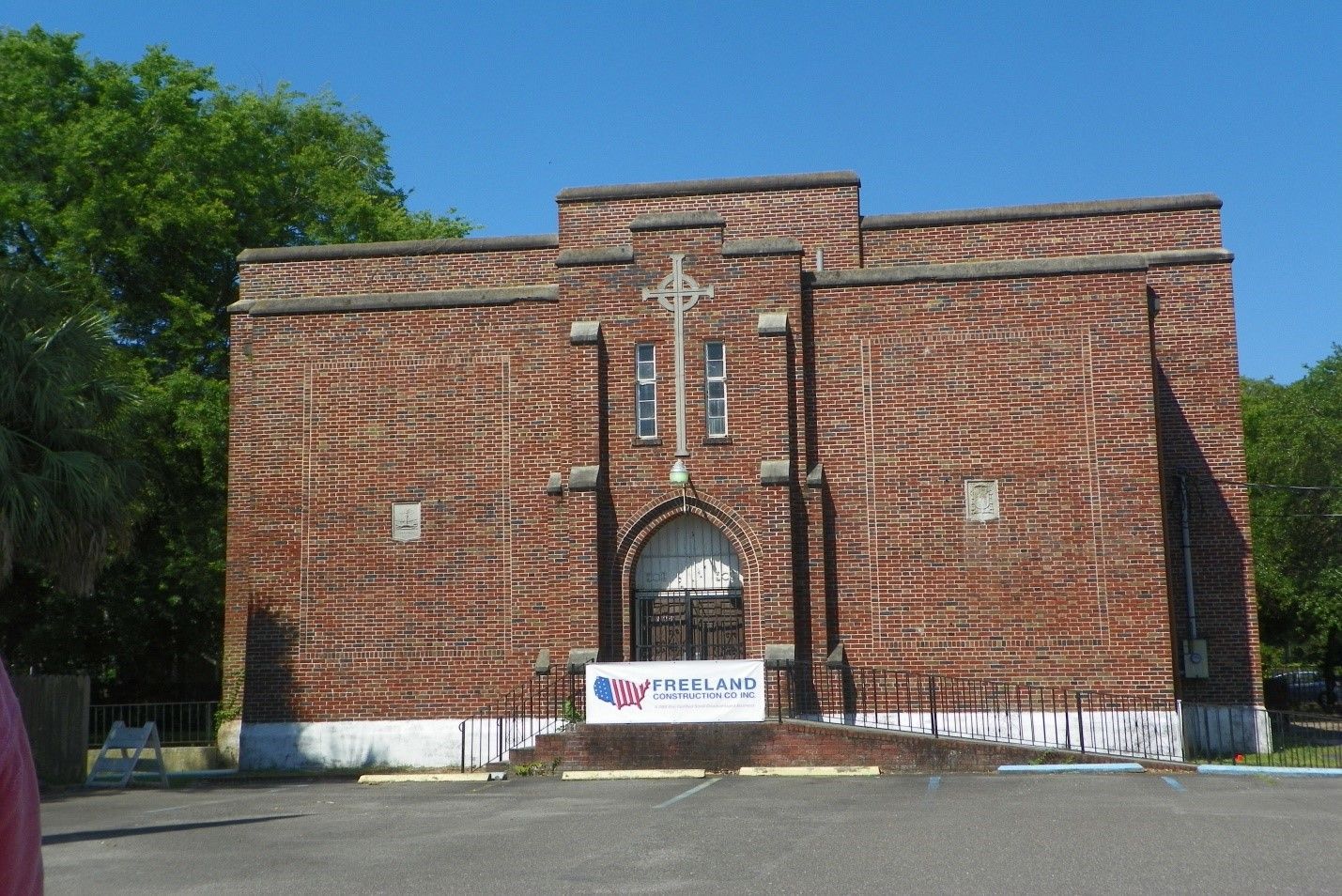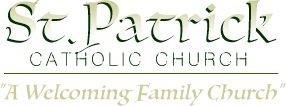History
A History of St. Patrick Catholic Church
“Serve the LORD with gladness: come before his presence with singing.’ Psalms 100:2
In November 1828, Bishop John England purchased a track of land on the corner of St. Philip and Radcliff Streets for a cemetery. He had hoped that eventually, a church would be erected. On September 1, 1835, a meeting was called asking all Catholics living north of Calhoun Street to meet with him to consider a new parish in Charleston’s Neck Area. The committee of seven people reported on September 15th that there were nearly 50 families, a number of individuals and a considerable number of Colored people living in the area. Some with transportation felt that St. Mary’s and Cathedral were sufficient. After much discussion, the meeting approved the views of the Bishop and plans for a new church go underway. Reverend John Fielding was appointed and on Sunday, January 29, 1837, he celebrated Mass for the first time at the King Street residence of Mr. P. B. Bouton.
Funds were raised and on St. Patrick’s Day 1838, the cornerstone was laid and work began. By the end of December, the humble edifice, though not completely finished, was ready for divine service. It was a framed building 50 feet in length, 36 feet wide and 24 feet high. There were neat galleries on each side. The one on the north was for Colored parishioners and on the south for Whites. Space on the west was for the organ. There were 36 pews which were rented.
Money was collected and invested to replace the small church. However, during the Civil war the funds depreciated in value and investments failed. The parish was bankrupted.
Reverend Daniel J. Quigley, appointed in 1884, saw the need for a larger church. His first move was to purchase the ground on the northwest corner of St. Philip and Radcliff Streets and plans were drawn for the new church. Work progressed rapidly.
Then came the earthquake of August 31, 1886. Fortunately, Father Quigley was in charge of funds raised throughout the country. He pushed for St. Patrick and on December 12, 1886, Mass was held in the basement of the new church. On May 15, 1887, St. Patrick was solemnly consecrated. In December 1891, the organ was installed and used at the 5:00 a.m. Mass on Christmas morning. Finally, in 1899, all work was completed. Monsignor Quigley died on November 27, 1903 and is buried in one of the tombs in front of the church.
In 1937, St. Patrick Parish served a population almost half the size it was at the time of Monsignor Quigley’s death. By the end of WWII, many parishioners had moved west of the Ashley. St. Patrick’s membership and finance dwindled.
On September 22, 1967 both Immaculate Conception and St. Peter’s churches were closed. The functions of these two predominately African American parishes merged with St. Patrick. The Reverend Philip Haggerty of the Congregation of the Holy Ghost Fathers was put in charge. Under his leadership and with William Headley and William Joyce, Assistant Priests, St. Patrick began to prosper. Soon after Father Joseph Moroney assumed his duties in 1970, a large tree fell atop the rectory on St. Philip Street next to the church. The entire building collapsed. The space now serves as a parking area. The number of priests had been cut from three to one when Father Moroney came so he built a smaller rectory across the street from the church on the St. Patrick Elementary School grounds.
During the administration of the Reverend Leonard Tuozzolo, July 1975-78, the first Parish Council was organized. With the help of the Diocesan Development Fund, a survey was made of the structural needs of the church. He established a budget; conducted a successful DDF Drive; repaired and painted the interior of Father Cleary Hall; encouraged the start of a Women’s Guild and initiated a meeting of the Men’s Club.
In 1978, the Reverend Egbert Figaro became the first black priest to serve in the Charleston area. He was assigned to St. Patrick and had the skills to carry out the findings of the structural survey. Much of the work was done by parishioners that allowed for more accomplishments with lesser funds. The Lower Church was re-designed. Chairs replaced the pews and the floors were carpeted. Added to the space were a pastor’s study, church office, and a small kitchen. A Year of Jubilee was also celebrated to observe the 100th and 150th Anniversaries of the church. In March of 1986, a re-enactment of the laying of the cornerstone was held. A time capsule was buried with a monumental stone to mark the burial site. The Jubilee celebration ended with the dedication of a new organ on April 10, 1988. In 1995, Father Phillip Howard became the last Holy Ghost Father to serve at St. Patrick before the religious order withdrew from South Carolina. Father Richard Harris then became the first Diocesan priest to serve at St. Patrick in 1995. Under his tenure, St. Patrick celebrated its 160th Anniversary.
It was a time not only for rejoicing, but also for current members to learn more about the heritage they shared with the White parishioners who populated the congregation before the 1967 merger. Accomplishments during the celebration year included the hiring of a full-time director of Christian Formation, Sister Mary Jane Golden. The parish also resumed use of its school building, St. Patrick Elementary, and in the process, began an extensive renovation project. Church groups, parish organization and Christian formation programs needed a place to meet.
In 2012, St. Patrick celebrated another great milestone by commemorating the parish’s 175 year history. The yearlong celebration began in grand style with a kickoff Mass held on January 29th, the same date the first Mass was celebrated in 1837. Pastor, Reverend Henry Kulah, describes the year in these words: “The year was a pivotal point for a stock taking and we gave it all the seriousness it deserved. The exercise created the awareness of the great potential for further growth in our midst. It also heightened our awareness of our many needs, especially our structural needs, such as office and meeting space and HVAC System. Indeed, we have been true to our theme for our 175th Anniversary, Remember, Renew and Rejoice. Together, we recalled our history and we rejoiced together in celebration. Now we are braced up to face the challenge of personal and parish renewal for the 21st century. May God be praised!”
St. Patrick Church continues to grow. In 2014 Our Lady of Mercy Church, another predominately African American parish located at 77 America Street in Charleston closed and was merged with St. Patrick.
In 2014, the St. Patrick Parish Pastoral Council Steering Committee was restructured under the leadership of the current pastor, Father Henry Kulah, who was assigned to St. Patrick in 2008. The new organizational format consists of a steering committee of nine members appointed by the pastor. The initial organizational meeting of the Committee was held on May 15, 2014. The first order of business was the revision of the Parish Mission Statement and the creation of a Vision Statement:
Vision Statement
“St. Patrick Catholic is a Welcoming, Family Church.”
Parish Mission Statement
St. Patrick Catholic Church is a faith-filled community forever growing in a relationship with Christ. We celebrate the presence of Christ in Word and Sacrament, demonstrate love and concern for all parishioners, teach by example and serve the needs of others in our community.
As our history continues to evolve, on May 19, 2015, a groundbreaking ceremony was held for the renovation of the old St. Patrick School building, the site of our new parish center. The historical building, erected in 1930, will be turned into a state-of-the art facility to be used as a new parish hall and church offices.
The ceremony included an 8:00 a.m. Mass celebrated by Bishop Robert Guglielmone. Plans call for retaining the exterior walls of the old 1930 building, while gutting the interior, reconfiguring the floor plan, and bringing the building up to date with the latest technology. Church offices will be moved to the First Floor of the renovated building with the entire Second Floor serving as space for a hall and kitchen. The facility will also include meeting a room for College Catholic Students in the Diocese.

July 15, 2021 Rev. Fr. Robert F. Higgins (Fr. Bob) began leadership of the parish, as Administrator.
Constant changes have taken place in the years at St. Patrick since 1837. But, one thing is constant: Jesus Christ is the same, Yesterday, Today, and Forever.





